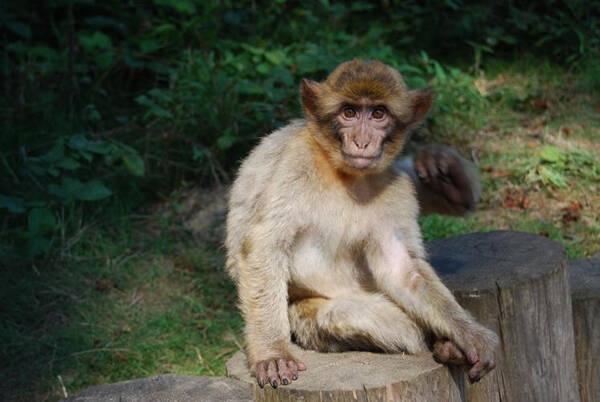Macaca sylvanus
IUCN
LCBasic Information
Scientific classification
- name:Macaca sylvanus
- Scientific Name:Macaca sylvanus,Barbary Macaque,Barbary macaque, Barbary macaque, Gibraltar ape
- Outline:Primates
- Family:M.family M.sapiens
Vital signs
- length:45-70cm
- Weight:5-19kg
- lifetime:About 20 years
Feature
Stout body, short tail, and cheek pouches
Distribution and Habitat
Origin: Algeria and Morocco.
Regionally extinct: Tunisia.
Introduced: Gibraltar.
The Mediterranean macaque is a ground-dwelling macaque that lives in the cedar, fir, and oak forests of the Atlas Mountains and the Gibraltar Mountains in North Africa. They have lived in these areas for at least 6 million years, taking advantage of the changes in North Africa's climate as it fluctuates from hot to cold and from wet to dry.
Appearance
The head and body length of the Mediterranean macaque male is 55-70 cm, and the head and body length of the female is 45-55 cm; the male weighs 7-19 kg, and the female weighs 5-8 kg. The tail is 1-2 cm long. The forelimbs are slightly longer than the hind limbs. Females are smaller than males. This species is covered in thick fur, which helps protect them from cold environments and maintain body temperature. The fur color ranges from yellow-gray to darker gray-brown. The fur on the chest and abdomen is much thinner than the rest of the body, and the cheeks are usually dark pink, but can also be a slightly darker peach pink. There is a distinct short tail, about 1-2 cm in length. The genitals swell during estrus. Like all monkeys, the Mediterranean macaque has large cheek pouches for storing food. The tooth formula is I 2/2, C 1 /1, P 2/2, M 3/3.
Details
Mediterranean macaque (scientific name: Macaca sylvanus) is also known as Barbary Macaque in English. It is an extremely tough animal.

The mountains where Mediterranean macaques live are only half the height of the Ethiopian highlands, living at an altitude of about 2,100 meters, which is generally a place where it is easier to survive. However, the poor diet of the Mediterranean macaques determines their unique discipline. Mediterranean macaques live in groups, with 12-60 members (average 24) and an older female macaque as the leader. Like the gelada, they spend a lot of time maintaining their relationships with each other. In order to protect the entire group, male Mediterranean macaques need to unite. They do not fight, but often pass a small monkey to each other - like passing a football until all the monkeys calm down.
The Mediterranean macaque is an extremely tough animal. The ancestors of the Mediterranean macaque are the only apes that crossed the Sahara Desert and reached the mountain forests of North Africa and Europe. The secret of their success lies in their diet, and they survive on the simplest food. They mainly eat grass, leaves, grass roots, fruits, young leaves, bark, roots, and occasionally invertebrates and insects. In winter, when thick snow covers the ground and food is scarce, they stay in the treetops, eating lichens, leaves, bark and needles of evergreen trees. At the first sign of spring, Mediterranean macaques leave the canopy and seek out fresh grasses and shoots on the forest floor. These snow monkeys wear thick, warm coats designed to handle freezing weather.

The mating season of Mediterranean macaques lasts from November to March of the following year. After the female monkeys are in estrus, they will mate with all the adult males in the same group. The gestation period is 147-192 days. After the baby monkeys are born, the male monkeys are responsible for taking care of the baby monkeys. They carry the baby monkeys on their backs, protect them, and play with them. These male monkeys treat all the young monkeys equally, but they are not actually the genetic fathers of the young monkeys they take care of. Only after fulfilling their obligation to take care of the young monkeys, they will have the right to mate with the female monkeys next year. The young monkeys mature in 3-4 years.
Females give birth to one baby every 2 years, and twins are rare. The young monkeys are weaned after 12 months, and males reach sexual maturity in 4-7 years and females in 2.5-4 years. Mature females stay in the family group, while males leave. The lifespan of Mediterranean macaques is usually 20 years.
There are about 200 Mediterranean macaques in Gibraltar, about 1,000-2,000 in the forests of North Africa, where they are native, and a total of about 1,200-2,000. Mediterranean macaques are well protected in Gibraltar, but their numbers are declining in North Africa, mainly due to deforestation by locals, which has led to the continuous loss of their habitat. Developing and maintaining national parks and forest reserves in Algeria and Morocco has become a top priority for their protection.
Listed in the 2008 Red List of Endangered Species of the World Conservation Union (IUCN) ver 3.1 - Endangered (EN).
Listed in Appendix II of CITES of the Washington Convention.
Protect wildlife and eliminate game.
Maintaining ecological balance is everyone's responsibility!








